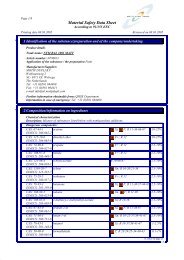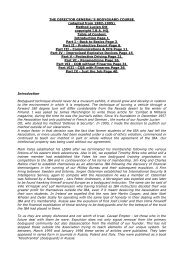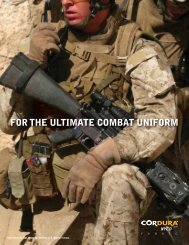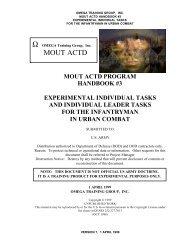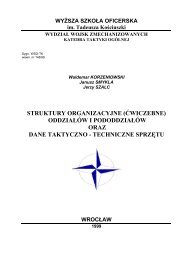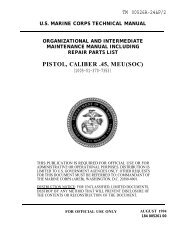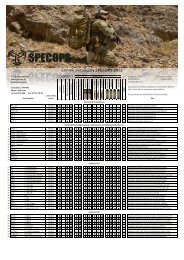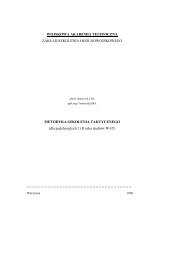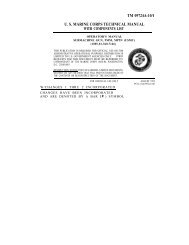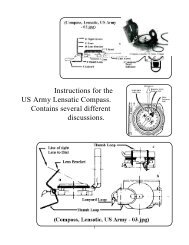mout actd program handbook #1 experimental tactics ... - SpecOps
mout actd program handbook #1 experimental tactics ... - SpecOps
mout actd program handbook #1 experimental tactics ... - SpecOps
You also want an ePaper? Increase the reach of your titles
YUMPU automatically turns print PDFs into web optimized ePapers that Google loves.
OMEGA TRAINING GROUP, INC.<br />
MOUT ACTD HANDBOOK <strong>#1</strong><br />
EXPERIMENTAL TACTICS, TECHNIQUES, AND PROCEDURES<br />
FOR THE INFANTRY RIFLE PLATOON AND SQUAD IN URBAN COMBAT<br />
_____________________________________________________________________________<br />
(2) Graphic control measures. The use of more graphic control measures and<br />
understanding of the commander’s intent at all levels becomes even more important to<br />
mission accomplishment in an urban environment. Phase lines such as streets and alleys<br />
and railroad lines can be used to report progress or to control the advance of attacking<br />
units. In large buildings, boundaries may be between different floors. Checkpoints aid<br />
in reporting locations and controlling movement. Contact points are used to designate<br />
specific, easily identifiable points where units make physical contact such as a mailbox<br />
or doorway of a building.<br />
R-40, Virtual Mission Planner: A virtual mission planner may be used to plan<br />
missions and conduct platoon and squad briefbacks and rehearsals. The virtual<br />
imagery of buildings and blocks may be especially useful in planning and rehearsing<br />
offensive operations. Visualizing where all the elements of a unit are during the fight<br />
will allow planning, increase situational awareness, and prevent fratricide.<br />
NOTE: Conventional maps and overlays must be maintained and used as a back up<br />
system if a virtual mission planner is used, in the event of a system failure.<br />
(3) Standing operating procedures (SOP). These are actions to be executed<br />
without command. They are developed and practiced during training. The SOP gets rid<br />
of many commands and eases the platoon leader’s job. An example of what might be<br />
included in a unit SOP is requirements for marking cleared rooms, floors, and buildings.<br />
Another good example is direct fire control. The most common method a leader uses to<br />
start and direct fire is by personal example:<br />
• The men hear the leader fire and see where he fires.<br />
• They fire at the same place.<br />
• The leader can use tracers to help the other soldiers find the targets.<br />
2-3. MISSION<br />
The platoon leader must receive, analyze, and understand the mission before he begins<br />
planning. The rules of engagement must be clearly stated. The platoon leader may<br />
receive the mission as a warning order, a fragmentary order (FRAGO), or an operations<br />
order (OPORD).<br />
a. Mission Analysis. When conducting his analysis, the platoon leader must<br />
consider the overall intent of the operation in regard to the requirement for clearance of<br />
the urban area and he must analyze all specified and implied tasks. In the offense, the<br />
platoon leader must understand if clearance means every building, block by block, or<br />
the seizure of a key objective, which may only require clearing along the axis of<br />
advance. The platoon leader must have these questions answered before he begins his<br />
_____________________________________________________________________________<br />
2-4<br />
VERSION 7, 1 APRIL 1999



